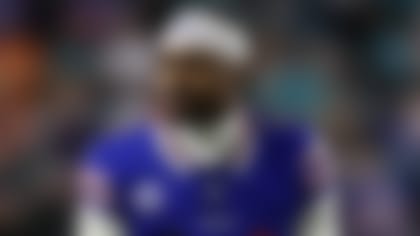After spending all summer analyzing teams, player situations, and tracking news to get prepared for the 2019 season -- it's time to get down to the fun stuff. To get you prepared to draft your squads this season, my fantasy team previews discuss every fantasy-relevant skill position player, positional strategy, and where I have players ranked versus their NFL.com average draft position (ADP). Let's get to it!
Chicago Bears
Quarterback: Mitchell Trubisky enters his third pro season with high expectations surrounding the Bears. In his first year with HC Matt Nagy, Trubisky's numbers improved drastically across the board. Trubisky's YPA (7.4 vs. 6.6), completions (67 percent vs. 59 percent), and TD rate (5.5 percent vs. 2.1 percent) were all sharply higher than his rookie season stats as Chicago installed their new offense. While Trubisky's efficiency rose, his results in fantasy football were a bit of a mixed bag. Trubisky's QB12 finish in points per game last season makes him look like a screaming value at cost (144 overall ADP) -- but cracks begin to show once we dig below the surface. Outside of a stretch of five performances in Weeks 4-10 where he finished top-10 in fantasy points at the position against TB, MIA, NE, NYJ, and DET, Trubisky recorded just one top-10 scoring week in his other 9 starts. For all intents and purposes, 2018 was Trubisky's rookie season after a year wasted with John Fox, but Chicago's signal-caller still has a way to go in his development. While Trubisky's stats improved in his second season, film study shows a highly inconsistent passer. Per PFF's charts, Trubisky threw an accurate pass (on target, in-stride) on just 57 percent of his attempts last season. Only Josh Rosen (51 percent), and Josh Allen (54 percent), Eli Manning (56 percent) were less accurate. On throws 10 or more yards downfield, Trubisky threw an uncatchable, inaccurate pass on a league-leading 45 percent of his attempts. A mid-season shoulder injury may have played a bit of a part of Trubisky's accuracy struggles, but this is now the second straight year where he's struggled mightily to deliver on target passes. Trubisky was 30th-of-35 QBs in PFF's accuracy marks as a rookie. The Bears don't need perfection from Trubisky to win a lot of games this season, and their surrounding talent guided by Matt Nagy provide the third-year passer with one of the best offensive ecosystems in the league. While Trubisky's accuracy issues are a major pause for concern, his ability to extend plays with his feet is a sneaky source of fantasy points. I'm willing to buy into Nagy and the Bears surrounding talent more than anything, but understand that Trubisky has a wide range of outcomes this season.
-- Trubisky (Rk: QB21 vs. ADP: QB19)
Running Back: No backfield has more open opportunity entering 2019 than Chicago. While Jordan Howard's departure leaves behind 250 carries and a 61 percent share of the Bears attempts from inside-the-ten, rookie David Montgomery is directly in line to soak up Howard's vacated role. Chicago entered the NFL Draft with a league-low five selections, but GM Ryan Pace thought so much of Montgomery that he traded up with New England (from 89 overall) to secure the back the Bears coveted. Montgomery won't win any track meets, but his shiftiness and ability to create his own is something Chicago has sorely missed in their rushing attack. Per my Yards Created analysis, no running back forced more missed tackles in the 2018 rookie class than Montgomery while only Darrell Henderson (8.2) created more yards per carry on off-tackle runs (Montgomery: 7.0 YC/A). Tarik Cohen has finished 10th and 6th among all backs in targets over the last two years, and he is the only roadblock to Montgomery potentially becoming a bellcow. Tarik Cohen can win weeks for you in fantasy, but RBs that rely almost solely on their pass catching chops are typically overvalued. Cohen has seen 12 or more touches in just 12-of-32 games in his career, and unless he rips off a big play or scores on days where he's not as involved in the game-plan, Cohen's weekly floor in fantasy is low. Mike Davis joined the Bears backfield this offseason, too, but he's a handcuff-only to Montgomery. Prior to having a career year in Seattle last season (4.6 YPC on 112 carries), Davis' previous 122 career totes gained 2.9 YPC.
-- Montgomery (Rk: RB24 vs. ADP: RB22); Cohen (Rk: RB30 vs. ADP: RB28)
Wide Receiver: This was Trubisky's target distribution in the 12 regular and postseason games where both he and Allen Robinson played last season: Robinson (93), Gabriel (68), Cohen (66), Burton (57), Miller (39), and Howard (22)... As Trubisky's go-to receiver, Allen Robinson is the only Bears pass catcher we can feel comfortable inserting into our fantasy lineups on Week 1. Including his 10/143/1 Wild Card demolition, A-Rob put up a healthy 4.8 receptions and 65.1 yards per game with Trubisky under center. Robinson's 13.8 PPR points per game with Trubisky would have tied him with Kenny Golladay and Tyler Lockett as fantasy's WR24. After gutting through most of his rookie season while playing a dislocated shoulder that he suffered back in Week 3, Anthony Miller is a chalky breakout candidate in 2019. Miller was one of college football's most efficient slot receivers in his final year at Memphis, and he spent nearly 70 percent of his snaps from the interior as a rookie. It's notable that Trubisky was far better targeting his slot wideouts (9.1 YPA; 103.7 rating; 68 percent completions) than his receivers split out wide (7.0 YPA; 82.4 rating; 62 percent completions) in 2018. However, for Miller to become a fantasy starter this year, Taylor Gabriel's role will need to be diminished some. Gabriel quietly ranked second on the Bears in targets with Trubisky last season, posting career-highs in catches (67) and yards (688). Miller is going to be more involved this season and remains a great buy in dynasty leagues, but he may be road blocked from a full-blown breakout with all of the Bears weapons at their disposal.
-- Robinson (Rk: WR28 vs. ADP: WR28); Miller (Rk: WR48 vs. ADP: WR55)
Tight End:: Trey Burton has post-hype sleeper appeal in the double-digit rounds of drafts after a so-so debut in Chicago, but the odds of him hitting big in fantasy are slim. Burton survived the war of attrition at TE in 2018 en route to a TE8 finish in 16 games, but his performance looks hollow after digging deeper. Even while Allen Robinson and Anthony Miller missed time due to injury, Burton saw six or more targets in a single-game just twice all of last season. Burton's low volume role made him very susceptible to poor performances. In the 10 games Burton did not score last year, he averaged 5.4 PPR PPG. However, after the top-6 TEs are off the board, everyone is playing the TE waiting game. At the very least, Burton offers a cheap avenue to a top-12 scoring offense.
-- Burton (Rk: TE12 vs. ADP: TE12)
Detroit Lions
Quarterback: Coming off of his worst fantasy finish since his rookie year (QB19), Stafford is on my "avoid" list in 2019. Stafford's pass volume has fallen in three-straight seasons (37.1 > 35.7 > 34.7 attempts per game), and new OC Darrell Bevell isn't afraid to run the ball. A veteran OC of 12 years with the Vikings and Seahawks, Bevell's attacks have ranked inside of the top-10 most run-heavy units eight times in his play-calling career. Long gone are the days of Stafford pushing 600 attempts in a season. In addition to going even more run-heavy in 2019, Detroit will likely be one of the slowest offenses in the league. FootballOutsiders records how fast offenses call plays by measuring how long it takes the offense to snap the ball from play to play. Bevell's tendency is to run a ton, and play it slow. His offense's have ranked 18th or worse in FO's seconds between snaps on offense in 10-of-12 seasons. In a year that is loaded with attractive late-round QBs, Stafford doesn't present a ton of fantasy upside on the now run-heavy, snail paced Lions.
-- Stafford (Rk: QB25 vs. ADP: QB24)
Running Back: While Stafford may fall from the weekly fantasy frey, Kerryon Johnson enters 2019 with immense upside... if the Lions feed him the rock. Detroit wants to be one of the most run-heavy teams in the league, and all their recent moves suggest as much. In addition to adding an old-school, ground and pound OC -- the Lions added dual threat T.J. Hockenson at eight overall in the NFL Draft. In addition to being one of the best receivers in the class, Hockenson was a mauler in the run game at Iowa. Detroit has now dedicated three of their last 6 top-100 picks in the NFL Draft on positions that are directly related to the run game in C Frank Ragnow, Kerryon Johnson, and Hockenson. LT Taylor Decker and LG Graham Glasnow were also top-100 picks in 2016. Detroit signed T.J. Lang in the 2018 offseason, but a neck injury cut his career short. Detroit's process is clear, though: They are building around the run. Before going down with a knee injury in Week 11, Johnson's involvement in Detroit's attack was a bit of a mixed bag. Johnson averaged just a 55 percent snap rate from Weeks 2-10 (excluding his five carry pro debut), and he saw his touch counts peak at 21 and bottom out at 10 in eight full starts. This year, fantasy owners have to hope that Johnson either plays more in the passing game or that he keeps the goal-line job over free agent addition, C.J. Anderson. At the very least, Johnson is no longer partially road blocked by passing down back Theo Riddick. In their eight games played together, Riddick sharply out-targeted Johnson 45 to 25 and ran more routes per game (23.6 to 15.4). With Riddick now out of the way, Johnson enters 2019 as the Lions foundation back. He's a high-end RB2 with RB1 upside.
-- Johnson (Rk: RB13 vs. ADP: RB13); Anderson (Rk: RB53 vs. ADP: RB65)
Wide Receiver: The good news for Kenny Golladay and Marvin Jones' fantasy outlooks in 2019 is that they are the only show in town at receiver. Golden Tate was still a Lion in eight of Golladay and Jones' 9 games played together last season, in which Tate led the trio in target share (27 percent). Even on a low-volume team, both Golladay and Jones can coexist as viable fantasy starters with now locked-in, high target shares. Back healthy off of a knee injury, Jones is a screaming value in all fantasy formats in 2019. Jones is the WR20 in PPR points per game over the last two seasons, and his ability to track the ball in contested catch situations has made him one of the league's most underrated deep threats. Per Next Gen Stats, Jones' catch rate is 12 points above expectation on his targets 20 or more yards downfield over the last two years. That is fourth-best behind Tyler Lockett, Tyreek Hill, and T.Y. Hilton in this span. Kenny Golladay is a great receiver, but even with Jones' knee injury baked into his cheaper draft day cost, I can't justify the gulf in price between the two. Golladay is routinely selected in the fourth round while Jones lasts into the 8th or 9th.
*-- Golladay (Rk: WR20 vs. ADP: WR19); Jones (Rk: WR32 vs. ADP: WR37) *
Tight End: You know the saying by now: Rookie TEs rarely produce. Unfortunately, it's tough to find space for Hockenson on a low-volume, run oriented Lions attack. Hockenson has to compete with two talented wideouts and two backs heavily involved in the passing game. Before taking Hockenson at 8 overall, the Lions added Jesse James on a four-year deal with $11M guaranteed in his contract. James will mainly just be a blocker, but even more competition for targets won't help Hockenson score fantasy points. Hockenson is my No. 6 ranked rookie in dynasty, but he won't find many of my teams in redraft leagues in 2019.
-- Hockenson (Rk: TE23 vs. ADP: TE20)
Green Bay Packers
Quarterback: After having his 2017 season cut short (broken collarbone), playing through a severely sprained knee and going through the end of the Mike McCarthy saga in 2018, Aaron Rodgers is slightly underrated in fantasy for the first time in his career. While the Packers offense lacked innovation and Rodgers dealt with injuries, he still managed to be the QB8 in points per game. While playing on that balky knee, it should come as no surprise that Rodgers threw a passing score on a career-low 4.2 percent of his attempts last season. The jury is still out on new HC Matt LaFleur, but an offseason to get healthy and a new scheme will (hopefully) be a breath of fresh air for the 36-year-old. The Packers have been the most pass-heavy team in the league on first and second down under McCarthy over the last three seasons, but that's about to change. Sure, Marcus Mariota is no Aaron Rodgers, but Tennessee leaned heavily on the run in LaFleur's first year calling plays. The Titans were 56 percent run-heavy on first and second downs last year, trailing only the Seahawks (59 percent) for the league lead. I'll be shocked if the Packers are one of the most run-heavy teams in 2019, but one change is for sure: Rodgers has a play-caller that isn't afraid to run. With slot man Geronimo Allison back healthy, field stretcher Marquez Valdes-Scantling looking poised for a second-year leap, and 4-of-5 starting linemen returning, the Packers supporting cast remains strong. Rodgers is not a no-brainer Tier 1 QB any more, but he remains a rock-solid top-6 option and a great bet to improve his TD total after a down 2018 in the red-zone.
-- Rodgers (Rk: QB3 vs. ADP: QB3)
Running Back: All of this talking about running on early downs hasn't been for nothing. Despite being one of the most explosive and efficient RBs in the league, former HC Mike McCarthy criminally under-utilized Aaron Jones. To be fair, Jones was a rookie trying to earn playing time and he's dealt with injuries of his own, but Jones' numbers speak for themselves. Over the last two seasons, Aaron Jones ranks first in YPC (5.5), he's second in gains of 10 or more yards (16 percent), and he's tied with Gurley for second in rushing success rate (56 percent). McCarthy's willingness to commit to Jones was a part of his undoing, and it's hopefully something Matt LaFleur will remedy. Because Aaron Rodgers commands so much attention and the Packers almost always have three receivers on the field, Jones routinely faces favorable defensive situations. In fact, Jones has seen eight or more defenders in the box on just 17 percent of his carries per Next Gen Stats. That's the third-lowest rate among the 45 backs to see at least 200 in 2017-18. Jones has the potential to absolutely smash his fantasy ADP if LaFleur commits to Jones like he did with Derrick Henry late last year. Jamaal Williams and rookie Dexter Williams loom as competition, but Jones' runway to breakout is clear.
-- Jones (Rk: RB17 vs. ADP: RB16); Williams (Rk: RB64 vs. ADP: RB56)
Wide Receiver: Entering his age-27 season after setting new career high marks in targets (169), receptions (111), yards (1,386), and TDs (13) -- Davante Adams has one of the most straight-forward fantasy outlooks in 2019. Over the last two seasons, Adams has been the pinnacle of consistency, posting 60 yards and/or a TD in 21-of-22 possible contests with Rodgers under center. Adams' 19.9 PPR points per game trails only Brown and Hopkins in this span. Geronimo Allison has also been consistently productive with Rodgers under center. In eight games he's played over two-thirds of Packers snaps, Allison has averaged 14.2 PPR points per game with Rodgers on the field. Those figures would have made him the WR24 in 2017-18. Back healthy after suffering a concussion, strained hamstring, and groin injury last season, Allison is locked in as the Packers slot wideout. Allison notably spent around 40 percent of his routes in the slot two years ago, so it's not like it'll be a brand new alignment for him. Per PFF's Scott Barrett, Rodgers has targeted his slot wideouts on 26 percent of his attempts in his career, the fourth-highest rate. Marquez Valdes-Scantling enters 2018 with a great role, too. While he may not see as many targets as Adams or Allison, MVS will stretch defenses deep. At 6-4, 206lbs with 4.37 wheels, MVS' freakish speed immediately gives Rodgers the deep threat he's lacked since Jordy Nelson left. Even as the second and third fiddle to Adams, both Allison and Valdes-Scantling are targets of mine every single fantasy draft. Rodgers has made a career out of elevating receivers into fantasy relevance, as he's supported two simultaneous top-24 fantasy wideouts in six of his 9 full seasons.
-- Adams (Rk: WR2 vs. ADP: WR2); Allison (Rk: WR39 vs. ADP: WR43); Valdes-Scantling (Rk: WR41 vs. ADP: WR49)
Tight End: Green Bay's receiver room behind Davante Adams was in flux last season, but Jimmy Graham just wasn't a key part of the pass offense. Graham caught 3 or fewer balls in 10-of-16 games last year while his 5 targets inside-the-ten was well below his career average (9.1 in eight full seasons). Graham is a good bet to improve his TD total in 2019 because we are buying a Rodgers bounceback, but I'd advise against chasing Graham's past production and the Packers tight end role. Aaron Rodgers' tight ends have produced just four top-12 fantasy seasons with no finish better than Jermichael Finley's TE9 campaign in 2011. Now entering the final few years of his career, Graham doesn't offer much upside with all of the Packers mouths to feed. Keep an eye on rookie Jace Sternberger as a super deep sleeper. In his lone season as a starter at Texas AM, Sternberger led his team in receptions, yards, YPR, and TDs while leading all college TEs in gains of 20 or more yards (21). Graham is now 32-years-old, and the Packers used their 75th overall pick on his long-term replacement. I drafted Sternberger in the third-round of both my dynasty rookie drafts this summer.
-- Graham (Rk: TE19 vs. ADP: TE19)
Minnesota Vikings
Quarterback: Like the Lions, the Vikings are going to attempt to run the ball more often with OC Kevin Stefanski calling plays. HC Mike Zimmer fired John DeFilippo after Week 14, and installed Stefanski as OC for the teams remaining three games. The Vikings ran the ball on 48 percent of their plays under Stefanski in Weeks 15-17, which is a stark contrast from DeFilippo's attack that ran the ball just 33 percent of the time (second-lowest rate in the league). With the disclaimer that this is a three-game sample size, Kirk Cousins averaged 27.3 pass attempts per game with Stefanski. Cousins threw the ball over 40 times per game with DeFilippo. The Vikings also brought in run game guru Gary Kubiak as an advisor/assistant HC, further cementing Minnesota as a run-first team. A change in philosophy will hurt Kirk Cousins in the long run, but the Vikings have a bit of luck on their side early in the season. Outside of a Week 4 date in Chicago, six of the Vikings first 7 games set up as potential high scoring affairs against beatable secondaries (vs. Falcons, at Packers, vs. Raiders, at Bears, at Giants, vs. Eagles, at Lions). We want fast starts in fantasy, and even though the Vikings may lean more heavily on the run in 2019, Cousins' early season schedule is ripe for scoring. Quietly coming off a career-high in completions, a career-low INT rate, and his fourth-straight QB1 (top-12) finish -- Cousins is yet another enticing late-round QB target.
-- Cousins (Rk: QB17 vs. ADP: QB21)
Running Back: Dalvin Cook has only appeared in 15-of-36 possible games in his career, but when he's been on the field, he's been the Vikings workhorse. In 13 full starts, Cook has gained 97.7 scrimmage yards on 18.0 touches per game. Cook has played on 73 percent of Vikings' plays in his starts, while his 23.1 routes run per game rank eighth-most in this span. Cook's bellcow role has helped him produce as fantasy's 10th-best running back in points per game (15.9). With only rookie Alex Mattison, Mike Boone, and Ameer Abdullah behind him on the depth chart, Cook will continue to be leaned on heavily. If Minnesota does commit to running the rock like HC Mike Zimmer wants, Cook offers league-winning fantasy appeal in the late second-round. Cook's health is the only knock against him after tearing his ACL in 2017 and missing five games with a hamstring strain last season. Still only 24-years-old, this is Cook's chance at a full-blown breakout.
-- Cook (Rk: RB10 vs. ADP: RB11)
Wide Receiver: This was Kirk Cousins 2018 target distribution in the 15 games with both Diggs and Thielen on the field: Thielen (148), Diggs (146), Rudolph (79), RBs (74), Treadwell (51)... Stefon Diggs and Adam Thielen are the only show in town in Minnesota, and they are both being drafted somewhat near each other on NFL.com (Thielen: 27 overall; Diggs: 36 overall). Thielen (WR8) has slightly out-performed Diggs (WR11) in points per game over the last two years, but Thielen cooled off down the stretch last season (56 YPG in final eight games) after posting a record eight-straight 100+ yard performances in Weeks 1-8. Minnesota's threat of running more in 2019 lowers Thielen and Diggs' outlook just enough to put both of them slightly below consensus in my ranks and it's hard to go all-in on Vikings receivers since there are so many players around to target at cost (like Kerryon Johnson, Keenan Allen, T.Y. Hilton, Devonta Freeman, George Kittle, Zach Ertz, Amari Cooper, and Aaron Jones to name a few). Because the Vikes' pass-catcher corps is so concentrated -- Thielen and Diggs will comprise at least 55 percent of the targets once again -- the play here is to target Diggs in the fourth-round of PPR leagues when he slips past all of the attractive third-round options.
-- Thielen (Rk: WR11 vs. ADP: WR11); Diggs (Rk: WR14 vs. ADP: WR14)
Tight End: Minnesota used the 50th overall pick on Irv Smith in the draft and not-so-quietly fielded trade offers for Kyle Rudolph all offseason. Rudolph got a new extension this summer, but his new contract only added a little extra guaranteed money and gave Minnesota extra cap flexibility. Smith is entering camp still just 20-years-old and isn't ready for a full-time role yet, but he's been one of my main targets in the second and third rounds of dynasty rookie drafts. It's hard to feel comfortable taking Rudolph as your TE1 in fantasy this season, but he's plodded his way to TE10 and TE12 finishes in PPR points per game in each of the past two years while Kirk Cousins has supported a top-12 tight end in every season he's started. Thielen and Diggs will see the bulk of the targets here, but Rudolph should still command between 15-18 percent of Vikings' targets and remain heavily involved in the red-zone.
-- Rudolph (Rk: TE15 vs. ADP: TE14)





